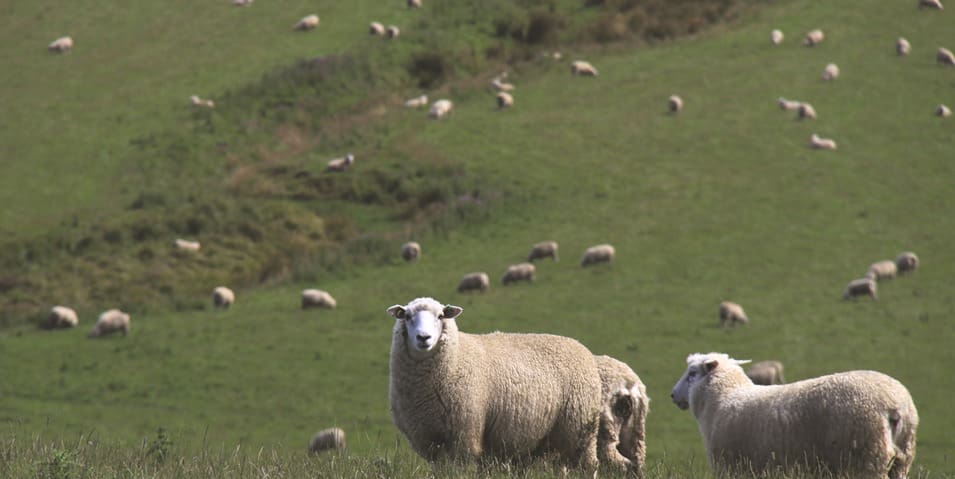
Sheep on Nithdale Station on New Zealand’s North Island.
A COMPARISON of New Zealand’s latest lamb performance figures with Australian data indicates there is still huge potential for improved lamb survival in this country.
Despite COVID-19 related processing restrictions and a widespread drought in the first half of 2020, New Zealand’s sheep and beef farmers have achieved a near-record 130.3 percent lambing percentage average for 2020.
Beef + Lamb New Zealand’s Lamb Crop Outlook report for 2020, that measures the lambing performance and forecasts lamb and sheep exports for 2021, said this only slightly lower than in spring 2019 when 131 percent was achieved. This compared with an average of 124 lambs per 100 ewes over the prior 10 years.
The New Zealand lamb marking figures are in stark contrast to the latest Australian figures, that show marking rates lifted 12pc for Merinos to average 92pc, and remained steady on year-ago levels for non-Merinos, at 109pc.
The preliminary figures came from Australian Wool Innovation’s and Meat & Livestock Australia’s October Wool and Sheepmeat survey, which has also indicated that drought conditions last year led to more productive ewes and ewe lambs being turned off are having flow-on effects for lamb numbers this year.
Leading Australian lamb survival consultant Jason Trompf said the NZ figures indicate there is more work to be done on lamb survival in Australian flocks, especially those non-Merino producers focussing on meat production.
“Our limitation is not conception, it is marking more lambs,” he said.
“There is a lot of scope for improvement in average meat or non-Merino flocks, and especially in meat production per hectare – how many ewes they are running, how many lambs they mark and ultimately how many lambs they turn off per hectare.
“Lamb growth rate is the other factor and probably of the three, it is the one where we are doing pretty good in Australia,” Mr Trompf.
“But there is a lot of scope for improving the number of ewes per hectare we are running in these non-Merino types and in marking rates.
“There is huge scope for improvement in lamb survival, when typically these non-Merino flocks are scanning around 150pc-plus of lambs.”
NZ sheep meat export volumes expected to be hit by drought
B+LNZ’s chief executive Sam McIvor said despite the challenges of 2020 including drought and COVID-19, NZ’s sheep farmers have demonstrated why they are the world’s best.
“Their resilience and the agility of their farming systems has meant they’ve performed outstandingly and this should be a real point of pride for our sector.”
However, B+LNZ said New Zealand’s lamb and sheep export volumes are expected to be more significantly impacted by the follow-on impacts of the drought, due to lower animal weights and the retention of sheep for breeding to rebuild stock numbers.
B+LNZ’s Economic Service estimates the number of lambs tailed (marked) in spring 2020 decreased by 1.5pc or 357,000 head on the previous spring to 22.9 million head. Most of the decline occurred in the North Island as a result of drought conditions.
“Although the average lambing percentage is slightly lower, it is worth noting that 2019 was a high performing season.”
The number of lambs tailed in the North Island declined 4.8pc (546,000 head) to 10.8 million head. Restricted feed supplies at mating resulted in lower pregnancy rates when scanning was completed. The severity of the impact of the autumn drought on the lamb crop was partially offset, however, by excellent climatic conditions at lambing. The most severe impact was in East Coast, with the total lamb crop for the region down 10pc.
In contrast, the total number of lambs in the South Island increased 1.6pc (189,000 head) to 12.1 million head. Otago was the major driver of the lift in the South Island, recording an increase in total lamb crop of 3.9pc.
The number of lambs from ewe hoggets also fell, as fewer ewe hoggets were mated and conception rates were adversely impacted by drought, particularly in the North Island.
B+L NZ said the lower number of lambs tailed is expected to reduce the number of lambs processed for export in the first quarter of the 2019-20 season – from October to December. The total number of lambs processed for export in the 2020-21 season is expected to decrease 4.5pc from 19.1 million head in 2019-20 to 18.2 million head.
The amount of lamb produced is expected to decrease 4.7pc due to a combination of fewer lambs and a slightly lower average carcase weight.
New Zealand’s number of adult sheep processed in the 2020-21 season is expected to decrease 10.8pc from 3.5 million head in 2019-20 to 3.2 million head. The sharp decline is driven by a 16.3pc decline in the North Island as sheep farmers recover after the number of breeding ewes sold in 2020 was higher than expected because of drought.
From a market perspective, early season pricing has been warmly received by farmers, and though there is uncertainty related to international economic conditions, the ongoing impact of COVID-19 and more latterly shipping logistics, the underlying fundamentals remain solid, according to B+LNZ’s New Season Outlook 2020-21, which was released in October.
The average export values are expected to be supported by the positive market fundamentals, with strong underlying demand for meat from safe and natural farming sources like New Zealand. Prices forecast at similar levels, or slightly above, five-year averages,” Mr McIvor said.
B+LNZ’s Economic Service Lamb Crop survey is of farmers in its Sheep and Beef Farm Survey, which covers a statistically representative sample of over 500 commercial sheep and beef farms.
The B+LNZ Lamb Crop 2020 report is available on the B+LNZ website here.
Source – Beef + Lamb NZ.

HAVE YOUR SAY